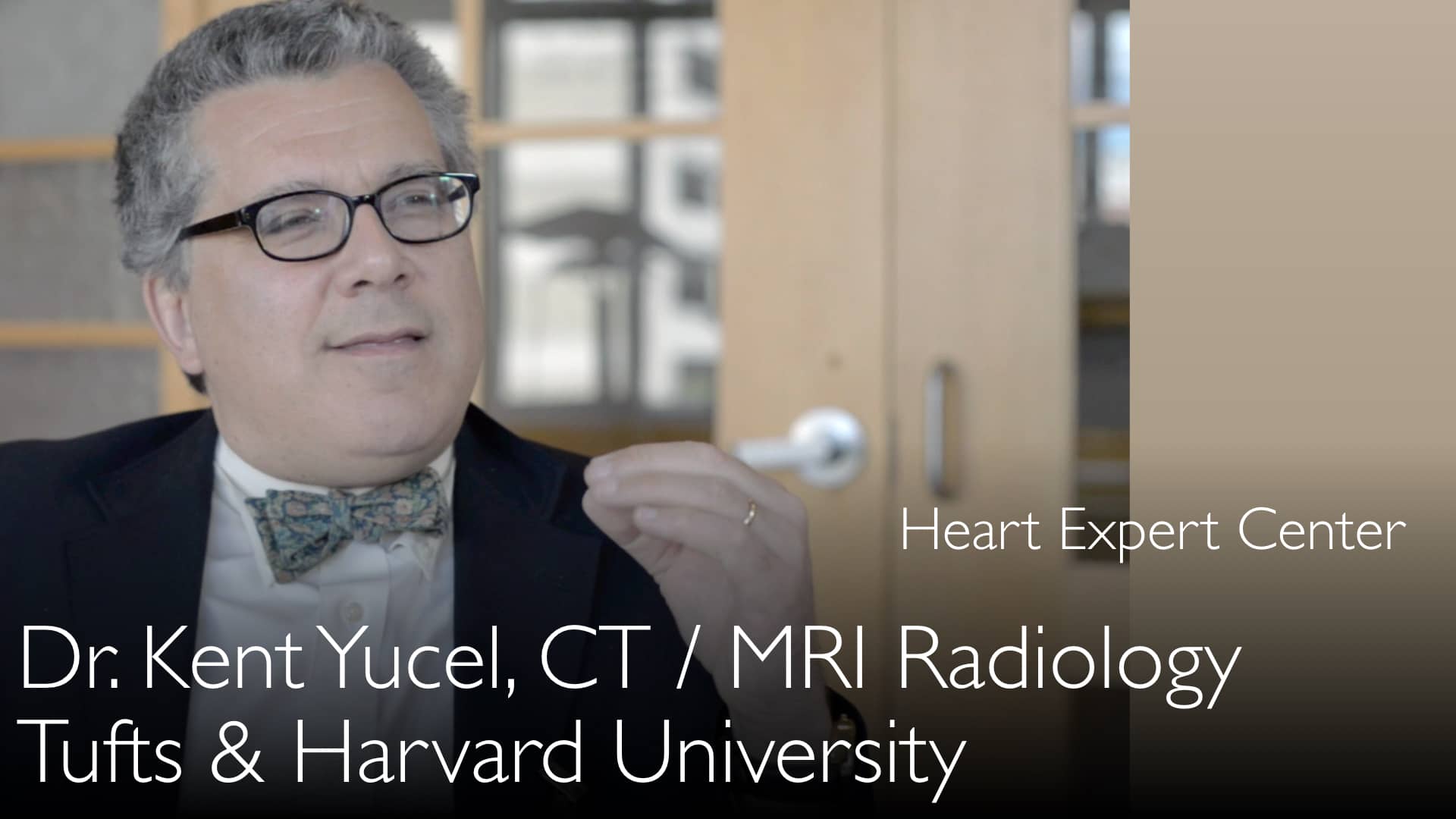Leading expert in vascular CT and MRI, Dr. Kent Yucel, MD, explains how to choose between CT coronary angiography and invasive coronary angiography. He details the distinct clinical roles for each diagnostic test. CT angiography is a powerful noninvasive tool for evaluating patients with suspected but uncertain coronary artery disease. It has a high negative predictive value, effectively ruling out significant blockages. This can prevent many unnecessary invasive cardiac catheterizations. Advances in technology have significantly reduced the radiation dose from CT angiography. It is now substantially lower than the radiation exposure from a traditional invasive angiogram.
CT Coronary Angiography vs. Invasive Angiography: A Clinical Guide for Diagnosis
Jump To Section
- CT vs. Invasive Angiography: Key Differences
- Ideal CT Angiography Candidates
- Radiation Exposure Comparison
- Clinical Decision Making with CT Results
- The Power of Negative Predictive Value
- Full Transcript
CT vs. Invasive Angiography: Key Differences
Dr. Kent Yucel, MD, clarifies the fundamental procedural differences between these two diagnostic tests. A conventional invasive coronary angiogram requires puncturing an artery, typically in the groin or wrist. A catheter is then threaded through the arterial system to the heart's coronary arteries to inject contrast dye directly.
In contrast, a CT coronary angiogram is a noninvasive multi-slice computed tomography scan. It is performed after injecting contrast dye intravenously. This key difference makes the CT approach far less invasive and generally safer for the patient.
Ideal CT Angiography Candidates
Dr. Kent Yucel, MD, identifies the patient population that benefits most from a CT coronary angiogram. The test is an excellent intermediate step for patients with symptoms that might indicate coronary artery disease, but where the diagnosis is uncertain. Before the widespread use of cardiac CT, nearly half of all invasive cardiac catheterizations performed on such patients returned normal results.
Dr. Kent Yucel, MD, explains that CT angiography is most helpful for this group. It can effectively eliminate a large number of these unnecessary invasive procedures. However, for patients who are clear candidates for coronary artery bypass surgery (CABG), the superior detail of an invasive angiogram is still required for surgical planning.
Radiation Exposure Comparison
Dr. Anton Titov, MD, and Dr. Kent Yucel, MD, discuss the important topic of radiation exposure from these cardiac imaging studies. Dr. Yucel confirms that a traditional invasive coronary angiogram typically gives a patient a much higher radiation exposure. When cardiac CT angiography technology first emerged, its radiation dose was similar to that of a classic cardiac catheterization.
Significant technological advances have dramatically changed this. Dr. Kent Yucel, MD, states that the radiation exposure from a modern noninvasive CT angiography is now only 20% to 25% of the level from an invasive cardiac catheterization study. While the dose is still higher than a standard CT scan, the reduction is substantial and represents a major safety improvement.
Clinical Decision Making with CT Results
The results of a CT coronary angiogram provide critical guidance for determining the next steps in a patient's care plan. As Dr. Kent Yucel, MD, outlines, the scan can lead to one of three clear pathways. For a significant number of patients, chest pain may be caused by gastrointestinal issues or other non-cardiac problems. The CT angiogram can provide reassurance by definitively showing no coronary artery disease is present.
For another group, the scan might reveal mild to moderate disease. This finding allows a physician to confidently recommend medical therapy instead of an invasive procedure. For the third group, the CT will show severe disease clearly requiring intervention. These patients will then proceed directly to a cardiac catheterization for stenting or surgery planning.
The Power of Negative Predictive Value
Dr. Kent Yucel, MD, emphasizes a major clinical strength of CT coronary angiography: its high negative predictive value. This statistical measure refers to a test's ability to correctly identify individuals who do not have a disease. A negative result on a CT coronary angiogram is extremely reliable for ruling out significant coronary artery blockages.
This reliability is paramount for both doctors and patients. It provides a high degree of confidence that symptoms are not originating from the heart. This allows clinicians to safely avoid an invasive procedure and investigate other potential causes of a patient's symptoms. Dr. Anton Titov, MD, highlights that this feature makes the test an invaluable tool in modern cardiology.
Full Transcript
Dr. Anton Titov, MD: CT coronary angiography or conventional angiography? CT coronary angiography changed the diagnostic approach to coronary artery disease. Who should have CT angiography rather than invasive conventional angiography? A leading CT radiologist discusses the advantages of computed tomography angiography and conventional angiography of the heart. What is the best use of coronary CT angiography today?
Dr. Anton Titov, MD: What is the difference between computed tomography CT angiogram and invasive angiogram?
Dr. Kent Yucel, MD: CTA and invasive cardiac catheterization are done for overlapping but distinct indications.
Dr. Anton Titov, MD: CT coronary angiogram—why is it done?
Dr. Kent Yucel, MD: CTA is best to screen patients with suspected but not obvious coronary heart disease. A medical second opinion can confirm signs of coronary artery disease on CT angiogram. It also helps to select optimal treatment for coronary artery disease. Seek a medical second opinion on heart disease and be confident that your treatment is the best.
Dr. Anton Titov, MD: What are the different types of angiograms?
Dr. Kent Yucel, MD: Traditional angiography involves puncture of the femoral or radial artery and threading a wire to the coronary arteries. CT coronary angiogram is a multi-slice cardiac CT scan after injection of intravenous contrast. That is the difference between conventional and CT coronary angiogram.
Coronary computed tomography angiogram is best to evaluate likely but not certain coronary artery disease. Diagnosing heart disease with cardiac computed angiography is less invasive and safer for the patient. It also involves less radiation exposure than invasive angiography.
Dr. Anton Titov, MD: For coronary artery evaluation, is CT angiography as good as the traditional invasive angiography by endovascular methods?
Dr. Kent Yucel, MD: Probably not. It depends on the application whether it is as good or not. For the most part, for actual coronary artery bypass surgery (CABG), that level of detail requires patients to still need cardiac catheterization.
The real role of non-invasive cardiac CT angiography is in patients who might have coronary artery disease but are not sure. CT angiography is a great intermediate step before doing cardiac catheterization.
Before cardiac CT angiography, almost half of "caths" (cardiac catheterization procedures) were normal. Patients had symptoms that might be coronary artery disease, or they might not have had heart disease symptoms. It was almost a flip of a coin (50/50 chance).
They would get an invasive cardiac catheterization to make sure it wasn't coronary artery disease. Those were the patients for whom cardiac CT angiography is the most helpful. CT angiography can eliminate a lot of normal invasive cardiac catheterizations.
Dr. Anton Titov, MD: Traditional coronary angiography will probably give a patient a much higher radiation exposure. What are the approximate numbers of radiation exposure in cardiac CT angiography?
Dr. Kent Yucel, MD: Compared to a normal CT scan, cardiac gating increases the radiation exposure for a patient. Cardiac gating is one technique of doing coronary CT angiography.
When it started, cardiac CT angiography radiation dose exposure was similar to classic cardiac catheterization in radiation dose. But there have been advances in technology that reduced the radiation dose.
Non-invasive CT angiography radiation exposure now is only 20% or 25% of the level of radiation exposure during invasive cardiac catheterization. Radiation exposure is still substantial. It is higher than a normal CT scan, but it is significantly less today than radiation exposure during a classic cardiac catheterization study.
Dr. Anton Titov, MD: So for patients who might not necessarily be going to surgery or coronary artery bypass grafting (CABG), non-invasive CT angiography might offer enough detail of heart arteries. It can help to decide whether to continue medical therapy or to proceed with invasive studies.
Dr. Kent Yucel, MD: Or no therapy. Many of these patients who present with chest pain may have problems with their GI tract (gastrointestinal tract) or esophagus. Or they may have other problems in their chest that are not heart-related.
CT angiography may be helpful in saying to patients, "You do not have coronary artery disease at all." Or if there is coronary disease, as you mentioned, coronary CT angiography can be helpful. It can tell patients, "You don't need a cardiac catheterization; you can just have medical therapy."
Or for a third group of patients, you can say, "You do need therapy," such as stenting of coronary arteries or cardiac artery bypass grafting surgery. In that case, those patients will all get cardiac catheterization.
Dr. Anton Titov, MD: This is very important for patients to know that there is a very strong negative predictive value of the non-invasive study of cardiac CT angiography.
Dr. Kent Yucel, MD: That is a real strength of coronary CT angiography: negative predictive value.
Dr. Anton Titov, MD: CT coronary angiography or conventional angiography? How to decide which one to have?





